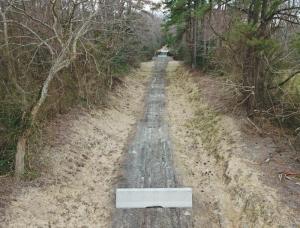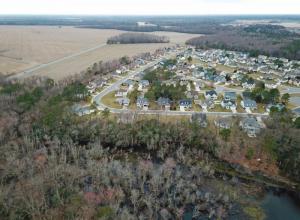Residents object to Milton trail lighting

As Milton prepares to extend a pedestrian and bicycle trail, town residents came out March 18 to object to a proposal to install lighting along the trail.
Delaware Department of Transportation plans to begin construction in the fall on the trail extension, which runs through a wooded area from Federal Street to Lavinia Street. The $1 million project - funded 80 percent by state funds and 20 percent by grants - includes a plan to install conduits along the trail for lighting. Town Manager Kristy Rogers said installing lights would cost an extra $175,000, but would mean the trail could be open 24/7. Who would pay for the lights is yet to be decided.
The first phase of the trail, from Chestnut Street to Federal Street, is already lighted, but as residents pointed out, that section is in a commercial area.
Rogers said the town has been working with Delmarva Power, which has suggested two styles of lights: Granville, a lamp-style light that projects upward and outward, or a shoebox style that projects downward. The cost of installing the two styles is the same, but Rogers said the difference is the maintenance cost: $950 per month for the Granville lights and $600 per month for the shoebox style. While the state is paying for the trail, the town is responsible for maintenance of the trail and lights.
Walt Tydings, 129 Carriage Drive, who worked on the Northern Central Railroad trail in Maryland, said that project came to cover 42 miles of trail without lights. He said that trail did not use lights out of respect for the privacy of homes close to the trail. Tydings said the trail is open from dawn until dusk yet it has been a happy marriage of users and nearby homeowners. He said if the town chose to use lights, he recommended the shoebox style because it is less intrusive.
Roy Turci, 212 West Shore Drive, said his home backs up to where the lights would go.
“You don’t live there,” he said. “I don’t feel like having a light in my window looking out the back of my house. A lot of things we’re being fed here are already a done deal. I don’t like that. I just don’t get what’s going on here.”
Turci said he also did not like the manner in which the trail area was cleared, with the old tracks and tree growth taken out. The site is not only being cleared for the rails to trails project but also for the water main extension into Wagamon’s West Shores, which will be installed around the same time. Turci said the planned lighting project is too expensive.
Mayor Ted Kanakos said he viewed lights along the trail as a security issue, enabling the police to see into the area easier. He said the town has lights in Milton Memorial Park, even though that is closed at night, for security reasons.
“To make that complete darkness, that would encourage crime, in my opinion. My preference would be for lighting, but it’s not a done deal because we don’t have the money for that,” Kanakos said.
Councilman Charlie Fleetwood said he wanted lighting along the trail for the safety of people that may be walking home at night from downtown. He said because it gets dark early in the winter time, lights would also allow people to walk in the evening.
“This is going to be a conduit between Wagamon’s Pond and the rest of the town,” Fleetwood said.
Public Works Supervisor Greg Wingo based on discussions with Delmarva Power, said there would be a total of 22 lights on 14-foot poles about 100 feet apart along the one-third-mile-long trail.
“At the end of the day, it’s about the safety of the residents out there,” he said. “We actually shrank down the lighting plan that was sent back to us from Delmarva Power just to spread those lights apart even more.”
Kanakos and Wingo said they do not expect glare from the lights or that the lights will shine brightly into homes.
Residents and Councilman Emory West suggested the idea of motion-activated lights or low-lying solar lights. Rogers said low-lying or solar lights were not available through Delmarva Power but the town could reach out to vendors if council wished to go that way. Under the current arrangement, Rogers said, Delmarva Power would supply and own the lights, while the town maintains the trail.
Council did not take further action on lighting.
Rogers said the trail will take two to three months to build and will have access points at West Shore Drive, Federal Street and Lavinia Street. She said construction would go from 7 a.m. to 5:30 p.m., five days per week. The trail will be lined with trees and shrubbery that Rogers said will serve as a buffer and sound barrier between the trail and surrounding houses.
Ryan Mavity covers Milton and the court system. He is married to Rachel Swick Mavity and has two kids, Alex and Jane. Ryan started with the Cape Gazette all the way back in February 2007, previously covering the City of Rehoboth Beach. A native of Easton, Md. and graduate of Towson University, Ryan enjoys watching the Baltimore Ravens, Washington Capitals and Baltimore Orioles in his spare time.

























































